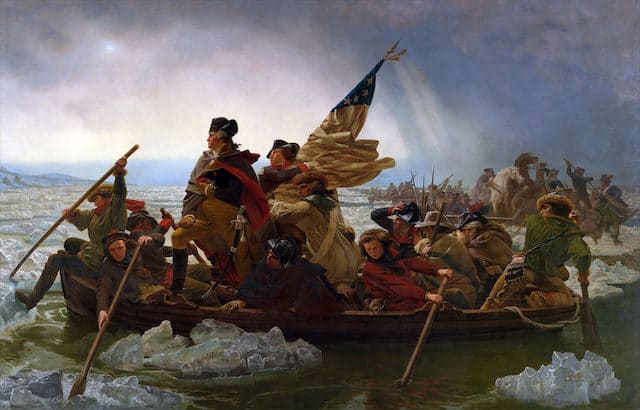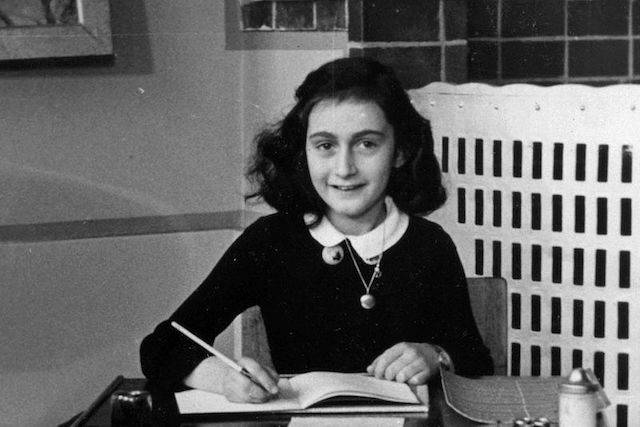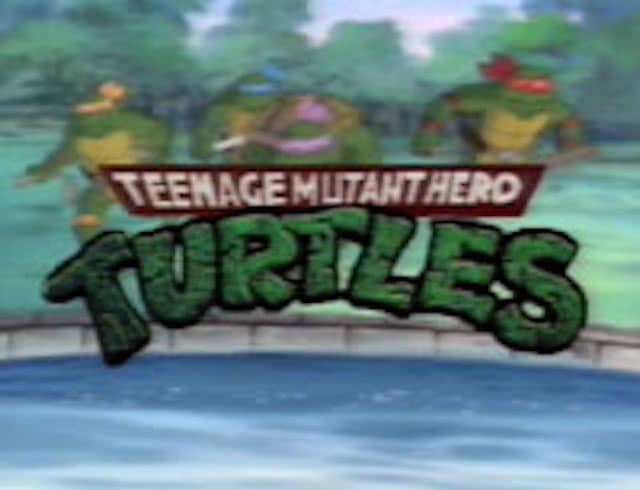Spend enough time online and you’ll eventually encounter a person mockingly talking about overly PC, censor-happy snowflakes who’re triggered by mean words. This, as it happens, isn’t a new phenomenon, or even one limited to one specific end of the political spectrum (who’d have thought it?). Here are 10 examples of the most innocent things busybodies of the era tried to censor, starting with…
10. A school once censored the painting of Washington crossing the Delaware

The words “George Washington” likely conjure one of two images in your head: his portrait on the dollar bill, or that one painting of him crossing the Delaware, looking like a total boss. The painting is easily one of the most famous depicting American history so you’d of course expect it to be found in history textbooks across the States, because why wouldn’t you? One, it looks awesome. And two, it’s a painting showing a guy in a boat. Who could possibly take offense to that?
Well, schools in Georgia sure as hell did when, in 1999, they had someone airbrush the photo after the superintendent of the Muscogee County school district, Guy Sims, insisted that it kind of looked like you could see Washington’s erect penis in the painting. Specifically, Sims put forward that the watch Washington is wearing in the painting kind of looked like a penis if you looked at it the right way, and he was worried that older kids would laugh at it. So, Sims did the only sane thing and had an art teacher mix up a kind of paint that was the same color as the one used for Washington’s trousers, and spent several days painting over the pseudo-dong in all 2,000 copies of a textbook the offending painting appeared in.
Just to clarify what happened here, because it’s glorious: a school official tried to censor American history because he personally couldn’t unsee George Washington’s erect penis in a 200 year old painting. We don’t know about you, but if anything, the idea that George Washington was so confident he literally went balls out while crossing the Delaware only makes us respect him more and they should probably edit paintings to make the watch look more like a penis.
9. Censors tried to cut a toilet flushing from Psycho
https://www.youtube.com/watch?v=8VP5jEAP3K4
Psycho is a genre-defining movie, regarded as one of the finest examples of psychological horror ever committed to film. The film broke new ground in several regards. However, the most impressive (considering how many films came before it) is that it was the first film ever to show a toilet flushing on screen… something censors objected to and tried have removed. For context, the offending flush takes place roughly 40 seconds before a character is brutally stabbed to death in a shower while completely naked.
Sure, censors also took offense to the shower stabbing scene, but Hitchcock was careful to frame and shoot that scene in such a way it technically complied with most every censorship rule about violence and nudity that existed. Hitchcock also made the scene consist of dozens of rapid cuts that actually showed very little, with most of the violence merely being hinted at rather than shown. This made it difficult for censors to actually point to any specific thing they objected to. The toilet flushing, however, was an unbroken shot that broke production codes of the era. However, because Hitchcock famously didn’t give a crap about stuff like that and was dogged in his persistence, censors eventually gave up trying to “fix” the film and let the toilet be, flush and all.
8. A store once put an “explicit lyrics” sticker… on an instrumental album
We think it’s safe to say that given today’s musical ecosystem, nobody has paid attention to a parental advisory sticker on an album in several years, presumably because physical album sales have been hemorrhaging for years. However, back in the days before streaming and YouTube, those little stickers were considered a death sentence for certain albums as they effectively prevented them from being sold by large chains of stores that wanted to project a “family friendly” image, Walmart being the most notable example.
Albums could be slapped with an explicit lyrics sticker for containing a single objectionable lyric, which Frank Zappa heard about before presumably saying “that’s cute.” We say this because Zappa holds the dubious honor of being the only artist known to have received a parental warning sticker for explicit lyrics on an entirely instrumental album.
Called Jazz from Hell, the album contains no lyrics of any kind. It does, however, contain a track simply titled G-Spot Tornado. This was enough for the Fred Meyer chain of stores to put an explicit lyrics warning label on the album even though, if they’d listened to it, the song and indeed the entire album are entirely lyric-less. Wow, it’s almost like heavy handed censorship without a deeper understanding of the medium you’re censoring is a bad idea.
7. The full quote of the famous Frankenstein “It’s alive!” bit was cut for 70 years
Until it gets horribly rebooted as part of the Dark Universe (a new cinematic universe centered around the classic movie monsters of the ’30s and ’40s that we’re absolutely not making up and kicked off with Tom Cruise’s terrible Mummy movie), Frankenstein will be fondly remembered as one of the greatest horror movies ever made. Perhaps the most iconic moment of the entire film is when the eponymous Dr. Frankenstein yells “IT’S ALIVE! IT’S ALIVE!” as a bolt of lightning brings his horrific creation to life.
That quote has been endlessly homaged and parodied in the 80-plus years since the film was released, which is odd since the actual full version of the quote was censored for, like, 70 of them. You see, in the original cut of the film, Frankenstein has a bit of dialogue after that, that was censored in the original cut, where he proclaims “Now I know what it feels like to be God!”
Censors judged the line to be blasphemous and demanded it be cut. This scene, among others that were cut for similar reasons, remained absent from the film for over half a century until they were all found and spliced back into a more comprehensive version of the movie a few years ago.
6. I Love Lucy was heavily censored due to even the implication of pregnancy
https://www.youtube.com/watch?v=uUXK6cP7QwE
Censors in the ’50s weren’t exactly a fun-loving bunch and TV shows and movies were effectively banned from showing anything that went against Hollywood’s incredibly narrow idea of traditional family values at the time. To this end couples couldn’t be shown sharing a bed or even kiss for more than three seconds. Censors were so against even suggesting the idea of sex that you couldn’t even say the word “pregnant” on TV. This became a problem for actress Lucille Ball when she became pregnant and her being with child was written into the show I Love Lucy.
Luckily for Ball and the writers, the show was one of the most popular on the air at the time so they were able to reach a compromise with censors, agreeing to only use the word “expecting” instead of pregnant to appease advertisers. A fact that is absurd in retrospect when you realize that not only did an entire season of the show incorporate Ball’s pregnancy into the plot, but one episode revolved around her giving birth.
Curiously, cigarette giant Philip Morris (who sponsored the show at the time) is said to have actually reached out to the show’s writers upon learning of Ball’s pregnancy to specifically request that her character not be shown smoking while pregnant. So we guess that’s one good thing, at least.
5. Two separate transgender characters have been censored in Mario games for Western audiences

Video games are a form of media consumed by people across the gender spectrum and in recent years a definite push has been made to represent individuals who fall outside the strict heteronormative narrative found in most popular games. This is, for some reason, a controversial statement that triggers people who like to make fun of the word triggered. As if the idea of people who are gay, lesbian, or transgender wanting to see themselves represented in their favorite medium is a big thing to ask.
Although the medium contains only a few well-known LGBT characters, at least one series has been flying the rainbow flag since the ’80s. We’re of course talking about the Mario franchise, which has introduced two transgendered characters in the past: Birdo and Vivian. In each case the character is described as being physically male, but identifies as female. The games don’t make a big deal out of this and most every character, including Mario, respectfully refers to them by their preferred gender pronoun during interactions.
For some reason this didn’t sit well with censors translating the English versions of the games each character was first introduced in, Super Mario Bros. 2 and Paper Mario: The Thousand-Year Door respectively, removing mentions that the characters are transgender to secure a child-friendly rating. In the case of Birdo, game manuals for Super Mario Bros. 2 did initially note that Birdo was a male who identified as female, but it was later changed for unknown reasons.
4. Sections of Anne Frank’s diary were censored because she talks about her vagina

Anne Frank’s diary is one of the most famous recollections of WW2, and it has remained one of the most studied and widely disseminated personal accounts of the war since it was published in 1947. A thing to keep in mind, though, is that Anne Frank’s diary was first and foremost a freaking diary that contained some of her most intimate thoughts and feelings. Frank never intended for her diary to be read by millions of people the world over, so she talks about some pretty personal stuff in it, like her vagina.
In fact, Frank’s diary contains an astonishingly detailed section in which she vividly describes her girly parts, which the guy who originally edited the whole thing decided to cut out wholesale. To be fair, the guy who edited Anne Frank’s diary was her father, so it’s understandable that he felt uncomfortable reading about his daughter’s burgeoning sexuality. However, there have been multiple examples of parents who object to the unabridged version of the diary being read in schools, even though in most cases it was going to be read by kids Anne Frank’s age.
3. The word “blowhole” was almost cut from a TV show because nobody knew what it meant

When it comes to making TV for kids, writers often get a lot of stuff past the radar of censors, whether it’s The Animaniacs joking about fingering Prince or a sultry Harley Quinn seductively asking the Joker if he wants to “ride his Harley” in Batman: The Animated Series. Sometimes, though, censors get suspicious and will pull creators up on a word or joke they feel is offensive somehow.
The most amusing example of this is the show The Adventures of Pete & Pete, which aired on Nickelodeon in the ’90s. Censors particularly zeroed in on one character’s repeated use of the word “blowhole” which they suspected was a new swear they’d never heard of. The creators apparently found this hilarious, and after composing themselves, walked into the Nickelodeon offices armed with a dictionary and read out the definition of what a blowhole is to the censors.
Apparently nobody in the office had any idea that the word blowhole was real and after realizing it’s just something you find on top of a whale’s head and absolutely wasn’t just a PG-version of the word a-hole , let the creators use it as much as they wanted.
2. Spider-Man wasn’t allowed to hurt pigeons in the ’90s
https://www.youtube.com/watch?v=UrcFWBOXuaw
You often see the words “Ruining my childhood” thrown around online and most of the time it’s hyperbolic nonsense. However, we are genuinely about to say something that could potentially cause you to never look at one of the most popular interpretation of Spider-Man the same way ever again.
Okay, ready? In the 1994 Spider-Man cartoon, Spider-Man never punched a single bad guy. Seriously, go back and watch any fight scene from that series. Spidey never throws a single punch, or at least never one that lands.
This is because censors of the time heavily objected to showing violence of any kind on screen and drafted a list of things Spider-Man couldn’t be shown doing. This list included punching bad guys, threatening people with being set on fire, and hurting pigeons. That last one sounds made up, but it isn’t. You see, in addition to being told to never show Spider-Man punching someone, the animators were also asked by censors to make it clear than whenever he landed on a rooftop he didn’t disturb any birds. Despite this, the creators were able to make a half-decent show by having Spider-Man outwit his enemies or tie them up with his web rather than socking them on the jaw.
1. The ninja turtles weren’t ninjas in the UK

There are really only four things you need to know about the Teenage Mutant Ninja Turtles and they’re all right there in the name. They’re mutant turtles who struggle to balance teenage angst with the responsibility of being a sick ninja.
UK censors, however, objected to exactly one quarter of the show’s content when TV stations acquired the rights to air the 1987 animated series over there. Specifically, they objected to the word “ninja” due to it having violent connotations and forced the creators to brand the show “Teenage Mutant Hero Turtles” instead. Also, before anyone asks, yes – they forced them to change the theme song, too.
Along with demanding that of any mention of the word ninja was cut, British censors asked the creators to downplay use of weaponry in fight scenes. The most ridiculous thing, though, is that even though one of the turtles hit people with a sword censors went after Michelangelo the hardest because showing nunchucks in British media was illegal at the time. This forced the creators to remove Michelangelo’s nunchucks and replace them with a grappling hook in the third season.
We did originally plan to have a smarmy closing remark go here, but we think the image of a British guy angrily yelling about a turtle slapping people around with two sticks joined by a piece of rope is funnier than anything we could come up with.